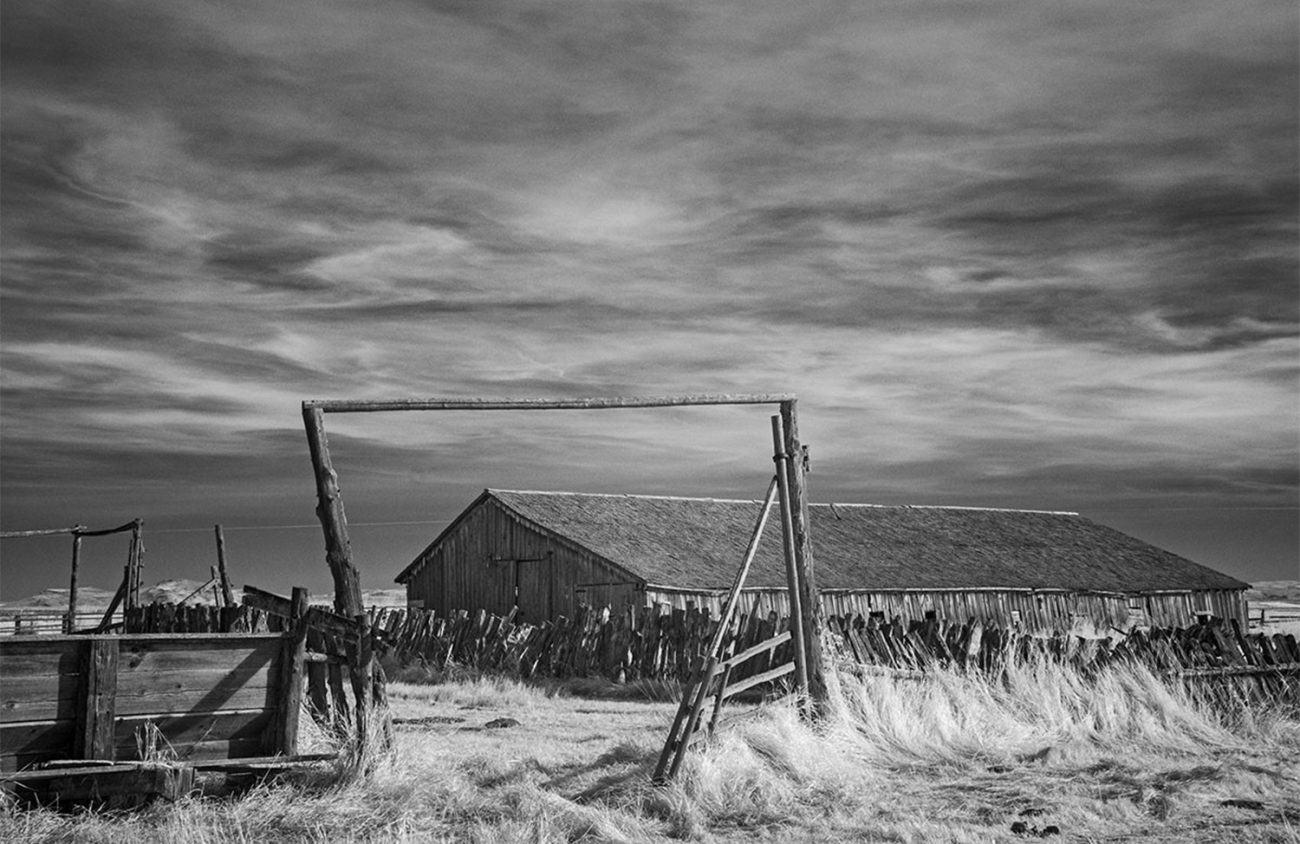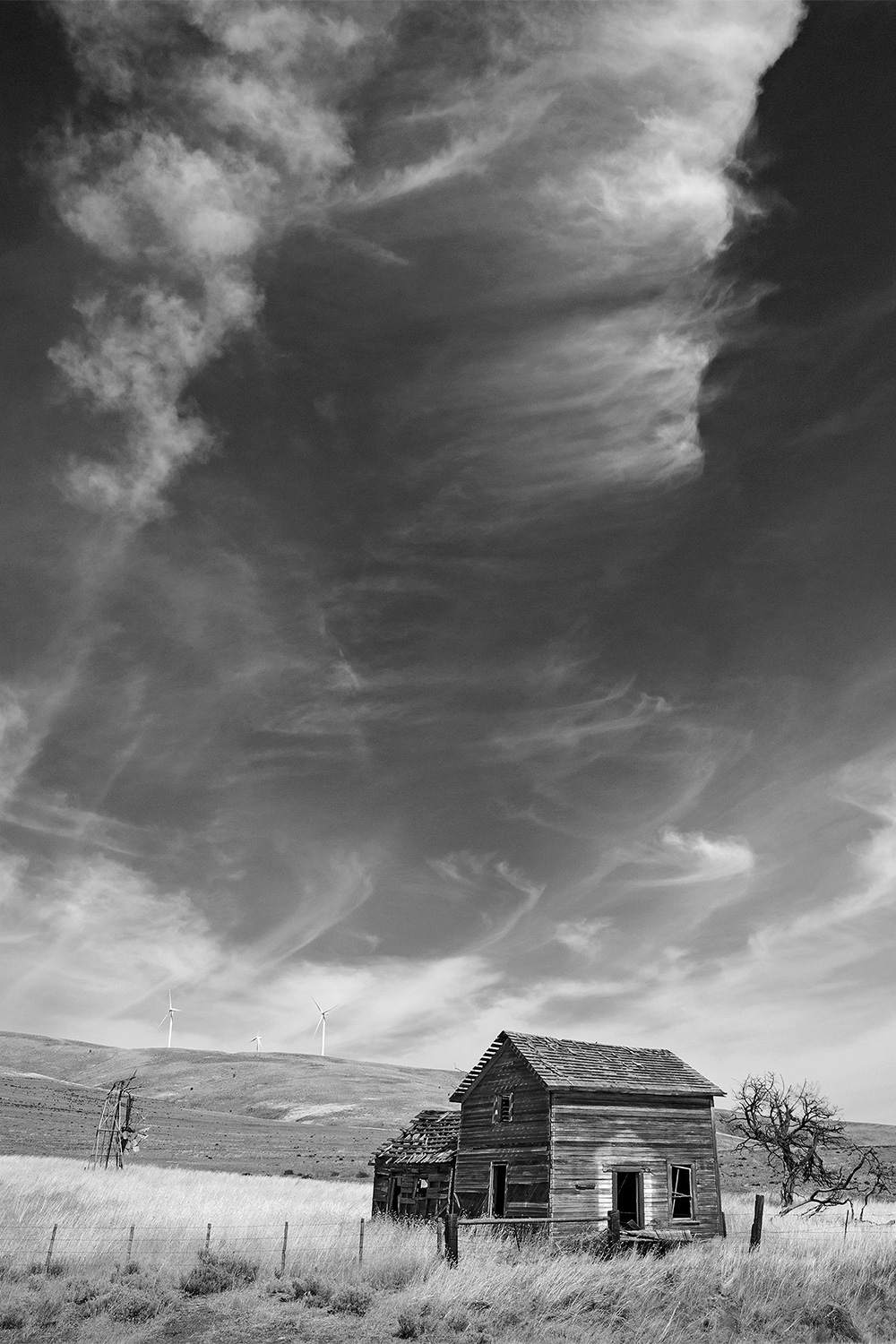Rich Bergeman has a history of switching technology, some of which is highlighted in the 28 often stunning black and white photographs currently showing at White Lotus Gallery. The Vanishing West, on display until June 12, represents the photographer’s interest in different methods of taking and printing images, and an ongoing interest in things gone by.
He first came upon the theme of abandoned places more than 30 years ago when taking pictures of windows and doors from inside abandoned buildings. It’s a favorite subject among photographers, he says. Being in a dark place with the light streaming in, I imagine, the drama takes care of itself.
Bergeman worked his way out of the dark toward increasingly larger, more panoramic views, from under a dark cloth or inside a darkroom to digital photography and now infrared. He went outside for exterior shots of dilapidated buildings or just their remnants. “Remnants” is the word he uses when talking about his subject matter.
He has a two-step process in his approach. First he researches an historical topic dealing with the Western U.S., particularly in Oregon or Washington, then he sets out in search for remnants of said history. He calls this work his “projects.” That he refers to them as “projects” and not “series” may reflect that he is not someone whose language is entrenched in artspeak. That is most likely because he came to fine art photography through the back door, so to speak, by way of a career in journalism.
He earned his degree in journalism in 1971 and worked in that field before he landed a job as a journalism and photography instructor at Linn-Benton Community College in 1981. Having worked as a freelancer beforehand, he feels lucky to have been an instructor, for the steady work and, as he’s now retired, for the pension which helps him to work on his projects.
His self-published art books, available for viewing in their entirety at blurb.com, include Tidewaters: Looking Back on Oregon’s Coast Range Rivers (2012), High Desert Dreams: The Lost Homesteads of the Fort Rock Basin (2013) and The Land Remembers: Photographs Inspired by the Rogue River Wars (2018).
He’s used such alternative processes as pinhole photography, silver, platinum/palladium, digital and most recently infrared. Each method of taking pictures and printing, he says, has its advantages and limitations. The pinhole camera has a wide angle and he loved using it because it has the “same focus from here to infinity.”
When working with traditional photography methods he followed the purist ideology, championed by the street photographer Henri Cartier-Bresson, that the image should be composed while looking through the frame — before it’s taken. Chopping it up afterward would be sacrilegious, according to this aesthetic principle.
Bergeman resisted moving to digital technology it seems, as long as possible, but once he did he found new freedom of range and started shooting panoramic landscapes — because he could.
With each change in technology he asks the same question: “What can I use this on?”
Most recently he’s been walking around his neighborhood looking up and taking pictures of clouds. This has led him to a website that offers a cloud identification service, and he’s now “a card carrying member of the Cloud Appreciation Society,” which is a real organization that posts a cloud a day from its members around the world.
His “Pandemic Skies” reflect that he has given in to cropping. They are cropped so only the tops of trees appear at the bottom, if at all. Just a hint of the earth remains.
Using infrared, skies are dark and trees glow. Four of the infrared cloud photographs will be on display at Benton County Historical Museum this June through September.
Looking at abandoned places, you can’t help but wonder, why? What went wrong there? Sometimes a remnant is an entire building, other times it’s a post. Still other times, there are no remnants left at all. Such was the case when Bergeman searched the area where the Rogue River Wars were fought, and the photographs from that project are all landscapes — the places in nature where the wars were fought.
The mystery appeals to Bergeman. And he thinks it goes with using the infrared. He sees the technology as a metaphor: using light outside the visible part of the spectrum to take pictures of things unknown.
The Vanishing West continues through June 12 at White Lotus Gallery, 767 Willamette Street. Hours are 10 am to 4 pm Tuesday through Saturday. Masks and social distancing required; private visits available by appointment at 541-345-3276 or lin@wlotus.com.

